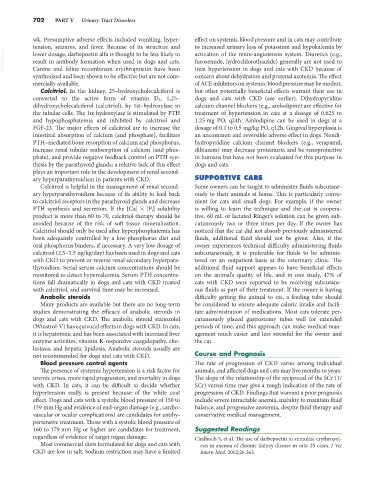Page 730 - Small Animal Internal Medicine, 6th Edition
P. 730
702 PART V Urinary Tract Disorders
wk. Presumptive adverse effects included vomiting, hyper- effect on systemic blood pressure and in cats may contribute
tension, seizures, and fever. Because of its structure and to increased urinary loss of potassium and hypokalemia by
VetBooks.ir lower dosage, darbepoetin alfa is thought to be less likely to activation of the renin-angiotensin system. Diuretics (e.g.,
furosemide, hydrochlorothiazide) generally are not used to
result in antibody formation when used in dogs and cats.
Canine and feline recombinant erythropoietin have been
concern about dehydration and prerenal azotemia. The effect
synthesized and been shown to be effective but are not com- treat hypertension in dogs and cats with CKD because of
mercially available. of ACE inhibitors on systemic blood pressure may be modest,
Calcitriol. In the kidney, 25–hydroxycholecalciferol is but other potentially beneficial effects warrant their use in
converted to the active form of vitamin D 3 , 1,25– dogs and cats with CKD (see earlier). Dihydropyridine
dihydroxycholecalciferol (calcitriol), by 1α–hydroxylase in calcium channel blockers (e.g., amlodipine) are effective for
the tubular cells. The 1α-hydroxylase is stimulated by PTH treatment of hypertension in cats at a dosage of 0.625 to
and hypophosphatemia and inhibited by calcitriol and 1.25 mg PO, q24h. Amlodipine can be used in dogs at a
FGF-23. The major effects of calcitriol are to increase the dosage of 0.1 to 0.5 mg/kg PO, q12h. Gingival hyperplasia is
intestinal absorption of calcium (and phosphate), facilitate an uncommon and reversible adverse effect in dogs. Nondi-
PTH–mediated bone resorption of calcium and phosphorus, hydropyridine calcium channel blockers (e.g., verapamil,
increase renal tubular reabsorption of calcium (and phos- diltiazem) may decrease proteinuria and be renoprotective
phate), and provide negative feedback control on PTH syn- in humans but have not been evaluated for this purpose in
thesis by the parathyroid glands; a relative lack of this effect dogs and cats.
plays an important role in the development of renal second-
ary hyperparathyroidism in patients with CKD. SUPPORTIVE CARE
Calcitriol is helpful in the management of renal second- Some owners can be taught to administer fluids subcutane-
ary hyperparathyroidism because of its ability to feed back ously to their animals at home. This is particularly conve-
to calcitriol receptors in the parathyroid glands and decrease nient for cats and small dogs. For example, if the owner
PTH synthesis and secretion. If the [Ca] × [P i ] solubility is willing to learn the technique and the cat is coopera-
product is more than 60 to 70, calcitriol therapy should be tive, 60 mL of lactated Ringer’s solution can be given sub-
avoided because of the risk of soft tissue mineralization. cutaneously two or three times per day. If the owner has
Calcitriol should only be used after hyperphosphatemia has noticed that the cat did not absorb previously administered
been adequately controlled by a low-phosphorus diet and fluids, additional fluid should not be given. Also, if the
oral phosphorus binders, if necessary. A very low dosage of owner experiences technical difficulty administering fluids
calcitriol (2.5–3.5 ng/kg/day) has been used in dogs and cats subcutaneously, it is preferable for fluids to be adminis-
with CKD to prevent or reverse renal secondary hyperpara- tered on an outpatient basis at the veterinary clinic. The
thyroidism. Serial serum calcium concentrations should be additional fluid support appears to have beneficial effects
monitored to detect hypercalcemia. Serum PTH concentra- on the animal’s quality of life, and in one study, 47% of
tions fall dramatically in dogs and cats with CKD treated cats with CKD were reported to be receiving subcutane-
with calcitriol, and survival time may be increased. ous fluids as part of their treatment. If the owner is having
Anabolic steroids difficulty getting the animal to eat, a feeding tube should
Many products are available but there are no long-term be considered to ensure adequate caloric intake and facili-
studies demonstrating the efficacy of anabolic steroids in tate administration of medications. Most cats tolerate per-
dogs and cats with CKD. The anabolic steroid stanozolol cutaneously placed gastrostomy tubes well for extended
(Winstrol-V) has equivocal effects in dogs with CKD. In cats, periods of time, and this approach can make medical man-
it is hepatotoxic and has been associated with increased liver agement much easier and less stressful for the owner and
enzyme activities, vitamin K-responsive coagulopathy, cho- the cat.
lestasis, and hepatic lipidosis. Anabolic steroids usually are
not recommended for dogs and cats with CKD. Course and Prognosis
Blood pressure control agents The rate of progression of CKD varies among individual
The presence of systemic hypertension is a risk factor for animals, and affected dogs and cats may live months to years.
uremic crises, more rapid progression, and mortality in dogs The slope of the relationship of the reciprocal of the SCr (1/
with CKD. In cats, it can be difficult to decide whether SCr) versus time may give a rough indication of the rate of
hypertension really is present because of the white coat progression of CKD. Findings that warrant a poor prognosis
effect. Dogs and cats with a systolic blood pressure of 150 to include severe intractable anemia, inability to maintain fluid
159 mm Hg and evidence of end-organ damage (e.g., cardio- balance, and progressive azotemia, despite fluid therapy and
vascular or ocular complications) are candidates for antihy- conservative medical management.
pertensive treatment. Those with a systolic blood pressure of
160 to 179 mm Hg or higher are candidates for treatment, Suggested Readings
regardless of evidence of target organ damage. Chalhoub S, et al. The use of darbepoetin to stimulate erythropoi-
Most commercial diets formulated for dogs and cats with esis in anemia of chronic kidney disease in cats: 25 cases. J Vet
CKD are low in salt. Sodium restriction may have a limited Intern Med. 2012;26:363.

